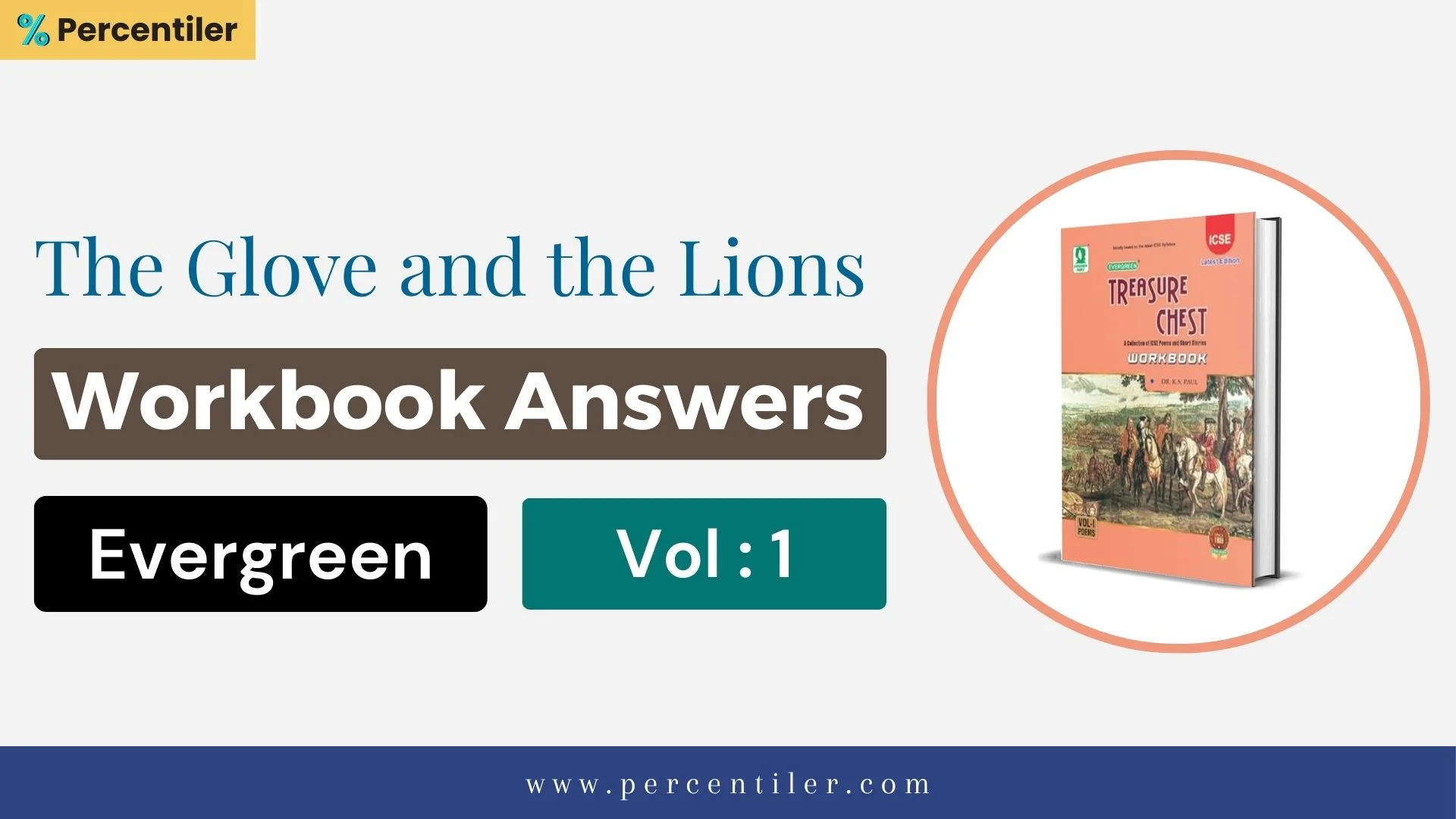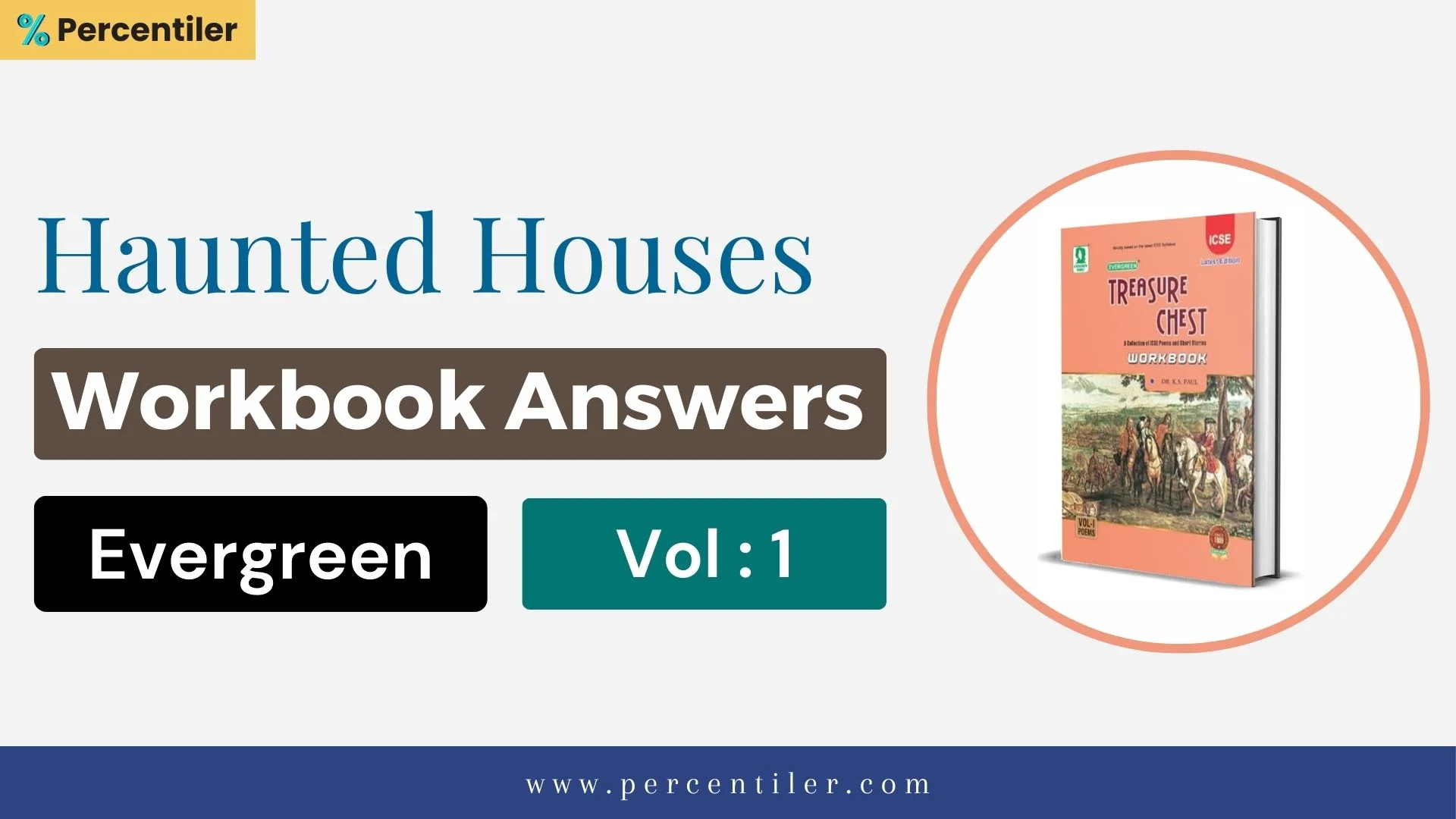
( Updated For ICSE 2026 Session )
Welcome to “With The Photographer Workbook Ans: ICSE Treasure Chest (Evergreen),” your gateway to exploring the captivating narrative of the story “With The Photographer,” featured in the ICSE English Literature Treasure Chest by Evergreen Publications. In this blog post, we offer detailed answers to the workbook questions, guiding you through the story’s intricate plot, vivid characters, and underlying themes.
Dive into each chapter and scene with our meticulously crafted solutions to multiple-choice and contextual questions, designed to deepen your grasp of the story’s exploration of human curiosity, the uncanny, and the blurred lines between reality and illusion. Through these answers, we unpack the author’s narrative techniques, use of dialogue, and descriptive language to build tension and evoke introspection.
The contextual questions challenge you to engage critically with the story’s structure and themes, such as the protagonist’s psychological journey, the role of perception, and the subtle commentary on modernity and isolation. This analysis hones your ability to interpret literary devices while fostering an appreciation for the storytelling craft.
Whether you’re a student mastering ICSE English Literature or a reader intrigued by tales that blend mystery with existential reflection, this workbook guide is your essential companion. Join us as we unravel the layers of “With The Photographer,” illuminating its twists, turns, and timeless questions—one chapter at a time.
Table of Contents
Summary :-
Author’s visits to a studio
The author decided one day to visit a studio for his photograph. As he asked the photographer to photograph him, the drooping man in grey suit looked at him without any enthusiasm. The author was asked to wait, although there was no other customer. Thus the author felt humiliated at the behaviour of this photographer. He had to spend his time in reading the old magazines/journals before he could be called into the room. There he read the Ladies Companion for 1912, the Girls Magazine for 1902 and the Infants Journal for 1888. He had the impression that he had made an unwarrantable intrusion into the privacy of this man’s scientific pursuits.
Photographer’s studio
The author was called into the studio after one hour. It was a dimly lit room in the middle of which the photographer had kept his machine i.e., his camera etc. A beam of light filtered through a sheet of factory-cotton hung against a frosted skylight. In fact, his studio was an old-fashioned room without any attractive appearance.
Photographer’s mannerism
As the author entered the room, the latter rolled his camera into the middle of the room and crawled behind it. Not feeling satisfied with something, the photographer tried to bring in more light by tearing at the cotton sheet and the window panes with a hooked stick. As he slipped back into the machine again, he drew a little back cloth over himself. The author felt that the photographer was praying. When he came out at last, he looked quite grim and shook his head.
Finding fault with the author’s face
The photographer, not being satisfied with the author’s face, told him that his face was quite wrong. This was humiliating for the author, though he already knew that his face was not at all photogenic. The photographer suggested that he could overhaul it and make it more attractive. The author felt that the photographer possessed a human side so as to make a person look more beautiful and bring about a transformation in human faces. In order to make the author’s face look better, the photographer took the author’s face in his hands and twisted sideways as far as it would go. He surveyed the face but was not satisfied. He went back to the machine and took another look. The author was asked to open his mouth a little. Likewise, the ears were found bad, then the eyes. The author was told to roll them under the lids. Many trifling postures were suggested.
Author’s annoyance
All this annoyed the author. He very candidly remarked that his face was his own and he had lived with it for forty years and he had no complaint. Rather he had loved it very much. Before the author could rise from his seat, the photographer had clicked his photograph just in a moment of animation.
No resemblance with the original face
It was just a negative copy which the photographer had produced. The author was asked to come back on Saturday. On the appointed day, the author went to get the photograph. On seeing it, the author felt shocked and asked if it was his real self. The photographer was proud of the product, but it just made the author disgusted. In fact, the photographer had employed the delphide for putting in a new one. Many unwanted things on the face were removed and he had retouched the mouth. Only the ears were allowed to remain the same, which were to be hidden in the final print.
Author’s candid rebuke
The author almost burst out and blasted the photographer with a bitter rebuke and scorn. Lashing out at the techniques of professional skills employed by the photographer, the author said that the photograph had no resemblance with his original self and he would not be able to gift the photograph to his friends to keep after his death. He told him that the photograph was now useless to him and it was a worthless ‘bauble’. With tears in his eyes, the author left the studio.
Workbook MCQs :
1. Choose the option that lists the sequence of events in the correct order.
1. The photographer had pulled a string.
2. The narrator says, I wanted something that depicted my face as Heaven gave it to me.
3. The narrator tells the photographer “This face is my face
4. The photographer tells the narrator to sit and wait.
(a) 4, 3, 1, 2.
(b) 1, 2, 4, 3
(c) 4, 3, 1, 2
(d) 2, 3, 1, 4
Answer:- (c) 4, 3, 1, 2
2. Select the option that shows the correct relationship between statement 1 and statement 2.
1. I still don’t quite like the face.
2. I swung myself round on the stool.
(a) 1 is independent of 2
(b) 1 is a contradiction of 2
(c) 1 is an example of 2.
(d) 1 is the cause of 2.
Answer:- (a) 1 is independent of 2
3. The photographer’s behaviour with the narrator made him feel.
1. happy
2. sad
3. angry
4. irritated
(a) 1 and 2
(b) 2 abd 3
(c) 3 and 4
(d) 1 and 4.
Answer:- (c) 3 and 4
4. “Is it me?” I asked.
Which of the following words best describes the speaker’s mood .
(a) disbelief and surprise
(b) sadness and frustration
(c) pleasing and playful
(d) none of these
Answer:- (a) disbelief and surprise
5. Which of these statements is NOT true?
(a) The narrator went to a photographer’s house
(b) The photographer took the narrator’s photograph
(c) The photographer used his technical skills to improve upon the photo
(d) The narrator was not satisfied with his photograph.
Answer:- (a) The narrator went to a photographer’s house
6. The story ‘With the Photograph’ is written by
(a) Katherine Mansfield
(b) Stephen Leacock
(c) W.Somerset Maugham
(d) Alphonse Daudet
Answer:- (b) Stephen Leacock
7. The photographer looked at the narrator
(a) cheerfully
(b) with enthusiasm
(c) without enthusiasm
(d) indifferently
Answer:- (c) without enthusiasm
8. The narrator was asked to wait for
(a) 15 minutes
(b) 30 minutes
(c) one hour
(d) 45 minutes
Answer:- (c) one hour
9. The studio was
(a) well-furnished
(b) quite modern
(c) dimly lighted
(d) very big
Answer :- For Full Answers Get The Workbook Answers PDF – View
10. The photographer had the looks of
(a) a sick man
(b) an angry man
(c) a natural scientist
(d) a crooked politician
Answer :- For Full Answers Get The Workbook Answers PDF – View
11. The second visit to the photographer was paid by the narrator
(a) the next day
(b) the same evening
(c) the next Saturday
(d) after a fortnight
Answer :- For Full Answers Get The Workbook Answers PDF – View
12. The narrator’s face was found to be by the photographer.
(a) quite ugly
(b) quite attractive
(c) quite wrong
(d) very innocent
Answer :- For Full Answers Get The Workbook Answers PDF – View
13. While waiting for the photographer the narrator
(a) read the latest news
(b) a journal for the infants
(c) listened to the music
(d) kept writing something in his diary
Answer :- For Full Answers Get The Workbook Answers PDF – View
14. What was the age of the narrator when he went to the photographer to have his photograph taken ?
(a) fifty
(b) forty
(c) thirty
(d) forty five
Answer :- For Full Answers Get The Workbook Answers PDF – View
15. The Delphide is a process employed by the photographer to
(a) add new features
(b) remove unwanted feature
(c) adjust body posture
(d) show attractive teeth
Answer :- For Full Answers Get The Workbook Answers PDF – View
Comprehension Passages :
Passage – 1
Read the extract given below and answer the questions that follow :
The photographer looked at me without enthusiasm. He was a drooping man in a gray suit, with the dim eyes of a natural scientist. But there is no need to describe him. Everybody knows what a photographer is like.
(I) Why do you think the photographer did not look at the narrator with enthusiasm?
Answer:- The photographer did not look at the narrator with enthusiasm because the narrator’s face had no attraction for him. He thought that the narrator’s face was wrong for a photograph.
(II) Explain the narrator’s attitude towards the photographer.
Answer:- The narrator’s attitude towards the photographer is that of dislike and displeasure. He does not even want to describe the photographer.
(III) What was the narrator’s experience with the photographer?
Answer:- The narrator’s experience with the photographer was quite depressing and uninspiring.
(IV) What tells you about the appearance of the photographer?
Answer:– The narrator describes the photographer as a man having the eyes of a natural scientist. He looked drooping in his gray suit.
(V) How did the narrator spend his time while waiting for the photographer?
Answer:- The narrator spent his time reading Ladies Companion for 1912, the Girls Magazine for 1902 and the Infants Journal for 1888 while waiting for the photographer.
Passage – 2
Read the extract given below and answer the questions that follow :
He was only in it a second, just time enough for one look at me, and then he was out again, tearing at the cotton sheet and the window panes with a hooked stick, apparently frantic for light and air.
(I) Who is ‘he’ here in this extract? Was ‘he’ at peace with himself?
Answer:- In this extract ‘he’ refers to the photographer. He was not at peace with himself as he looked frantic for light and air.
(II) What do you think of the studio where the photographer was to take the narrator’s photograph?
Answer:- The studio where the photographer was to take a photograph of the narrator was a dimly lighted and suffocating place.
(III) What was the photographer trying to do in his studio?
Answer:- The photographer was trying to take a photograph of the narrator. He adjusted the camera for this purpose.
(IV) What was the photographer’s reaction when he came out of the black cloth draped on the camera?
Answer:- He looked quite grave but dissatisfied with the narrator’s face. He expresses his anguish saying that the face is quite wrong.
(V) What was thought to be the problem with the face of the narrator?
Answer:- It was thought that the face of the narrator was wrong for not being photogenic. The photographer wanted to make several improvements in it to make it attractive in the photograph.
Passage – 3
Read the extract given below and answer the questions that follow :
“I’m sure it would,” I said enthusiastically, for I was glad to find that the man had such a human side to him. “So would yours. In fact,” I continued, “how many faces one sees that are apparently hard, narrow, limited, but the minute you get them three-quarters full they get wide, large, almost boundless in- -“
(I) What was the narrator sure of?
Answer:- The narrator was sure of his face not being photogenic.
(II) “The man had such a human side to him”. What does the narrator wish to convey about the man?
Answer:- The narrator here wants to convey that the photographer understands human limitations and helps in making good pictures even of those who do not have photogenic faces.
(III) How are the faces of the human beings made to look better?
Answer:- Photographers use their technical skills to make human faces look better in photographs.
(IV) What is the tone of the narrator when he says that human faces are made to look better?
Answer:- The tone of the narrator is sarcastic and ironical.
(V) Did the photographer himself need some improvement in his face or mind? How do you know this?
Answer:- The photographer himself needed some improvement in his mind as he does not behave well with the narrator. He needs to learn how to behave politely with a customer. His face also seems to need improvement as pointed out by the narrator.
Passage – 4
Read the extract given below and answer the questions that follow :
“The ears are bad,” he said; “droop them a little more. Thank you. Now the eyes. Roll them in under the lids. Put the hands on the knees, please, and turn the face just a little upward. Yes, that’s better.
(I) Which features are asked to be improved upon? What is the tone of the speaker here?
Answer:- The eyes, the ears, knees and the face are the features of the narrator that the photographer wants to improve. The tone of the speaker here is authoritative and commanding.
(II) Do you think the narrator is happy and satisfied with the photographer?
Answer:- No, the narrator is not happy with the photographer. He expresses his irritation and dislike against the photographer time and again. He even leaves his photograph with him.
(III) Which things other than the ones mentioned later in the context are to be set right?
Answer:- The narrator suggests that apart from his mouth, face, eyes, eyebrows etc., the photographer should put his own attitude right and not distort the originality of the photograph.
(IV) Did all these features of the narrator meet the due approval of the photographer? How do you know?
Answer:– No, the features of the narrator did not meet the photographer’s approval. He rather had a keen desire to improve upon them in the photograph using his own skills and different chemicals.
(V) What does the conversation in this extract tell you about the photographer’s art?
Answer:- The conversation in the extract indicates that the art of a photographer is not very simple and easy. A photographer wants to use his art to make the objects look more beautiful than they are in reality. For this purpose, a photographer does not hesitate in distorting the reality.
Passage – 5
Read the extract given below and answer the questions that follow :
“Stop,” I said with emotion but, I think, with dignity. “This face is my face. It is not yours, it is mine. I’ve lived with it for forty years and I know its faults. I know it’s out of drawing. I know it wasn’t made for me, but it’s my face, the only one I have-“
(I) Who is the speaker here? Who is he talking to? What is the occasion?
Answer:- The speaker here is the narrator. He is talking to a photographer. He talks to the photographer on the occasion of his visit to get his photograph clicked.
(II) What prompted the speaker to say, “It is not yours, it is mine”?
Answer:- The photographer pointed out several drawbacks in the narrator’s face. He told the narrator that his face needed improvement. It prompted the narrator to say that it
was his own face and not of the photographer that he was suggesting alteration in it.
(III) What is the tone of the speaker?
Answer:- The tone of the speaker is full of anger and irritation.
(IV) What does the extract tell about the narrator’s present mood?
Answer:- The extract tells that the narrator is annoyed and in a disturbed and angry mood.
(V) Which idea does the narrator try to convey through the extract?
Answer:- The narrator here tries to convey the idea that one must accept and appreciate one’s original self. It is better to be natural than being artificial and distorted.
Passage – 6
Read the extract given below and answer the questions that follow :
The photographer beckoned me in. I thought he seemed quieter and graver than before. think, too, there was a certain pride in his manner.
He unfolded the proof of a large photograph, and we both looked at it in silence.
“Is it me?” I asked.
(I) Where was the narrator asked to come and by whom?
Answer:- The narrator was asked to come inside the studio of the photographer. He was invited there by the photographer.
(II) What was the photographer proud of ?
Answer:- The photographer was proud of the proof of a large photograph of the narrator. He was to further work on it to develop the photograph.
(III) Both the photographer and the narrator looked at the proof of the photograph in silence. Why do you think both were silent ?
Answer :- For Full Answers Get The Workbook Answers PDF – View
(IV) What was the narrator’s reaction on seeing his photograph?
Answer :- For Full Answers Get The Workbook Answers PDF – View
(V) What other changes did the photographer want to make in the final finish of the photograph?
Answer :- For Full Answers Get The Workbook Answers PDF – View
Passage – 7
Read the extract given below and answer the questions that follow :
“Yes,” said the photographer thoughtfully, “that’s so; but I can fix that all right in the print. We have a process now the Sulphide for removing the ears entirely. I’ll see if–“
(I) What had not been tampered with as far as the body features were concerned?
Answer :- For Full Answers Get The Workbook Answers PDF – View
(II) To which question of the narrator does the photographer say ‘yes’? Does he agree to improve upon the picture?
Answer :- For Full Answers Get The Workbook Answers PDF – View
(III) Which features had the photographer retouched to make them look better?
Answer :- For Full Answers Get The Workbook Answers PDF – View
(IV) How do the photographers bring about changes in a photograph so that it looks completely different from the original?
Answer :- For Full Answers Get The Workbook Answers PDF – View
(V) How did the narrator express his anger at the photographer later?
Answer :- For Full Answers Get The Workbook Answers PDF – View
Passage – 8
Read the extract given below and answer the questions that follow :
“Coat it with an inch of gloss, shade it, emboss it, gild it, till even you acknowledge that it is finished. Then when you have done all that-keep it for yourself and your friends. They may value it. To me it is but a worthless bauble.”
(I) What is the narrator’s reaction on his photograph in his next visit?
Answer :- For Full Answers Get The Workbook Answers PDF – View
(II) Mention at least three different processes with the help of which the photographers change the features in a photograph?
Answer :- For Full Answers Get The Workbook Answers PDF – View
(III) Does the narrator approve of the techniques of the photographers in bringing about changes in the original photograph? How do you know?
Answer :- For Full Answers Get The Workbook Answers PDF – View
(IV) Would you support the narrator’s viewpoint or the photographer’s? Why?
Answer :- For Full Answers Get The Workbook Answers PDF – View
(V) Why does the narrator call the photograph a worthless ‘bauble’?
Answer :- For Full Answers Get The Workbook Answers PDF – View












